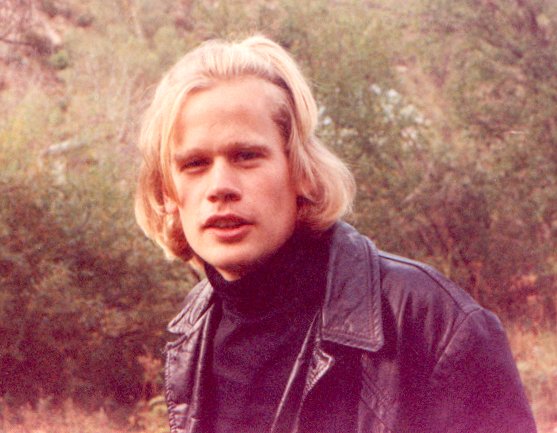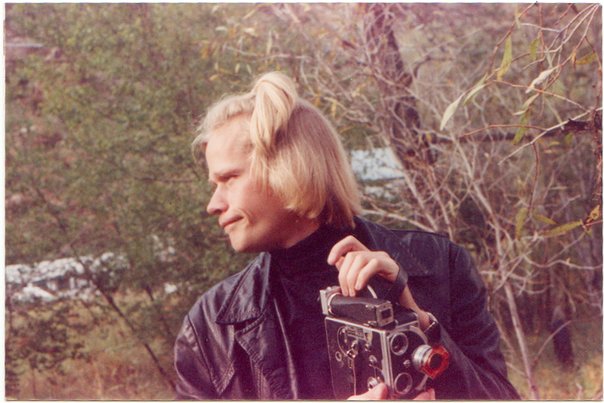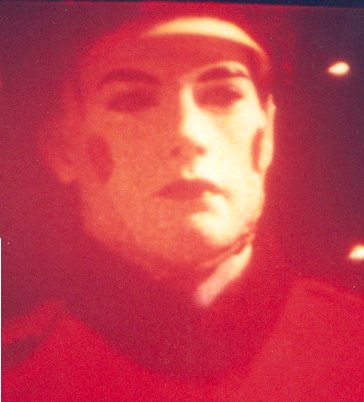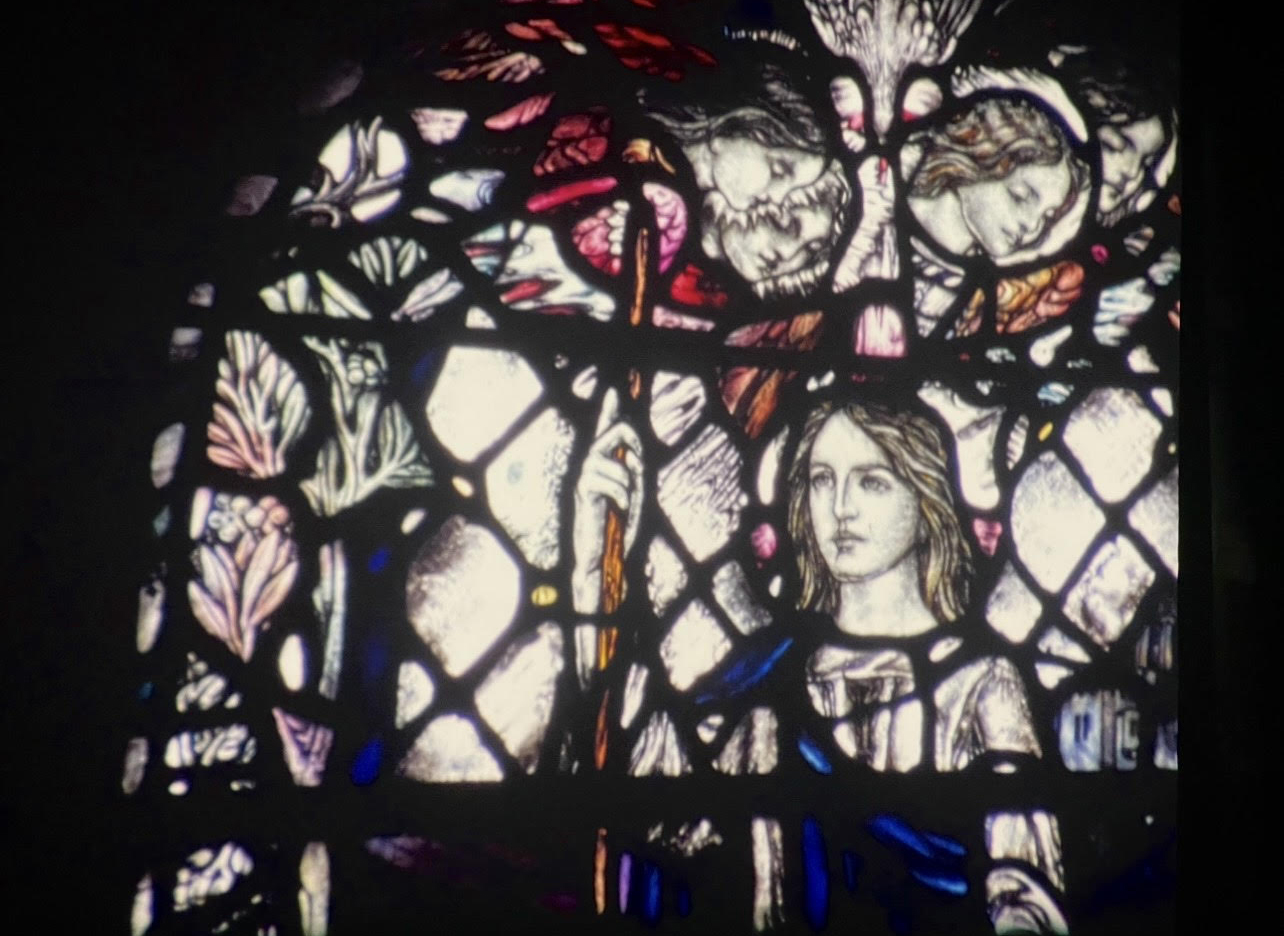Filmography
Love’s Choice | 1986 | 11 minutes | 16mm | B & W
Made by the artist group Boulder Biograph this film is an hommage to the one reel melodrama films of D.W. Griffith, the father of modern narrative film. This print is the only sound version in circulation. Love’s was entered in the Student Academy Awards (1987) and is in the collection of the Museum of Modern Art, NYC, New York.
Music by Hank Troy on piano
-- rent: $30, buy $500
Seven Pasades | 1986 | 21 minutes | 16mm | Color


This is a series of seven early 16mm films. Looking back at my student output in 1986-89 I found seven films that could be reworked and expanded beyond their original scope into a 7-part series exploring dreams, love, landscapes, and hypnogogic vision all from about the time of my early 20’s growing up in Boulder Colorado.
with Patrick Singson, Brent Poole, Mary Alden, Paul Hays and Jill Lundquist.
-- rent: $50
Romance in Solitude 1-4 | 1993 | 29 minutes | 16mm | Color


"Among those who attempt to exist without human sympathy, the pure and tender-hearted perish through the intensity and passion of their search after its communities, when the vacancy of their spirit suddenly makes itself felt. All else, selfish, blind, and torpid, are those unforseeing multitudes who constitute, together with their own, the lasting misery and loneliness of the world."
- Percy Shelley, from Preface to Alastor
"Cooper's ROMANCE IN SOLITUDE is a lyrical hero's journey in four parts. The filmmaker himself searches for beauty/truth, but stumbles over his own identity as well. He begins his quest in the zone between man and nature, speaking of love and languishing with desire. [In his quest] he encounters war, philosophy, religion. He idealizes beauty. This poor Knight fails in his quest. Ultimately, [ROMANCE IN SOLITUDE] is a beautiful, painful tale told by a man with a terrific eye for the flash and splendor of light through the lens of a hand-held camera."
- M.S. Mason
It’s an epic work of personal quest, isolation, gutsy inspiration,
and cinematic history which offers the best summation of what it means to be
transplanted from the wide blue yonder of Colorado to the madness of city
culture.
- Timoleon Wilkins
With Patrick Singson, Tanya Odins, Brent Poole, and Jill Lundquist
-- rent: $75
3 Diurnals and Nocturn | 2000 | 45 minutes | 16mm | Color
This film unfolds in three parts based on the spirtitual atmospheres called forth by the Christian observances of Good Friday, Holy Saturday, and Easter Sunday. The first part is a city symphony of my hometown Denver, CO. The second is a fever dream that recalls a children's carnival at night. The third part is composed of domestic scenes and birth metaphors that herald the appearance of my daughter Elena, the first of six children. The complete work is both the envisioned dream-song of a sick child and a lament for lost childhood in general. The first image of a forest thicket encloses the child's world like a stage while the final image of curtains closing suggests the conclusion of one act and the beginning of another.
Bruce Cooper's lovely light poem is a silent film. A rush of rich black and white imagery evokes a variety of experiences—a marching band, an Alaskan cabin, a snowstrom, fire festival, etc.—connected by exquisite shots of light reflected in the water. It's a spiritual journey, an investigation of peace."
—M.S. Mason,
Rocky Mountain News
-- rent: $100
In Michael’s Hour | 2007 | 15 minutes | 16mm | Color
In Michael's Hour from Bruce J Cooper on Vimeo.
Excerpt from “In Michaels Hour” on VimeoA reimagining of World War II as a cosmic struggle of light and darkness beyond the veil of the material world. The film utilizes found documentary footage shot during the German invasion of Russia in 1941-45; optically altered and painted-over to reveal occult layers and messages.
“I could feel a great sense of pain and questioning and searching through a seeming obscurity of meaning -- with a real feeling for complex visual rhythms integrating these layers of imagery… building toward your final celebration of the light (or so it felt to me), with the heaving waters suggestive, then, of emerging life forms and ultimate celestial reachings -- with intimations of immortality. Congratulations on a beautiful work. I hope many people are able to see it.”
- Marilyn Brakhage
The soundtrack is by the Boulder Colorado based ensemble Arkestra Pirata and performed on a variety of acoustic and electronic instruments.
-- rent: $40
Kinder Rose 1-7 | 2000-2021 | 100 minutes | 16mm | Color | Silent
https://www.youtube.com/watch?v=ADkD-d_DPD0
A seven-part 100 minute film about the beauty and terror of childhood as experienced in the daily rythms of an archetypal family - undramatic, shaped by the seasons and with intimations of spirits both heavenly and infernal, throughout. Drawn from images filmed over the course of 21 years at home in the Midwest, New England and New York City.
Part 2 includes short film “Gravity” 2004 by Mari Cooper.
"The sense of genuine timelessness as much as needed counterpoint to all 'retro' facsimiles thereof (which sums up just about everything these days...) Simply beautiful! Smashingly good as well: tight, rhythmic, self-assured - the life cycle at work, not afraid to show the darker side."
- Timoleon Wilkins
"I was also impressed by how little 'play acting' for the camera there was. With children you were able to catch a number of magic moments... raw, real, authentic, on the beach, in different seasons, playing on swings, feeding a farm animal. So much more meaningful than 'home movies' with kids taking on false faces with the awareness that the 'audience will be watching.' There is a certain monotony, and repetition, much more so than in adulthood, and a pattern that was repeated throughout the piece. A suggestion of day, and then night... The clear and meaningful activities of the day, followed by the processing of these events in the dream world (negative images, and ones with a filter (I assume) - so rich with color! The kite flying on the beach with the red and yellows... So delicious for the eye). This is a film about the passing of time. Children growing up in a blink of the shutter.
- Brent Poole
Kinder Rose series is dedicated to Iona Patrice Cooper - born 8/8/04, died 11/22/04
“The grass withers, the flowers fade but the word of God abides forever.” Isaiah 40:8.
To view Kinder Rose 6 click on the link below
https://www.facebook.com/1345865493/videos/1874501972948878/
-- rent: $150, buy: inquire for price
Ariadne’s Reel | 2023 | 7 minutes | 16 mm | Color
Based on the Greek story of Thesues, the Labrinth and the Minotaur. Ariadne, abandoned by her lover on the island of Naxos, becomes the subject of a sung ancient Greek hymn dedicated to the Muse. Dionysus, the god of the arts, unseen but present in the landscape, intervenes to bring about her apotheosis.
With Merritt Glover. Co-directed with Brent Poole.
-- rent: $30, buy: $400
World Without End 1 - Thomas Wolfe | 2023 | 8 minutes | 16mm | Color
An envisionment of my adopted hometown Asheville, North Carolina with an homage to Thomas Wolfe’s “Look Homeward Angel.” Abstractions mingle with images of animals, plants, stones, and angels.

“In his WORLD WITHOUT END, Bruce Cooper proposes and proves a universe of multiple dimensions, or perhaps parallel universes gently colliding with each other. Abstractions of redolent blue, backwoods landscapes of autumn leaves, Malick-ian fields of wheat, flowing water in many guises, worlds of animal, and of insect. All these alternate, intermingle, coexist, and are presided over by the Thomas Wolfe Memorial Angel in Cooper’s adopted home of Asheville, North Carolina. Like in Wolfe’s LOOK HOMEWARD, ANGEL, Cooper’s WORLD WITHOUT END directs us to a home we cannot return to aside from in myth, and in the archetypal world residing in our psyches, bones, and fingers. The world is indeed endless should we choose to accept it, and Cooper’s film alternately acclimatizes us consolingly to this reality, and guides us into and through this world of fragmentary shards of ecstatic beauty.”
- Brecht Andersch
As for the film itself--it is no doubt your best work yet. There's a maturity in the pacing; in the full-hearted fleshing out of visual chords (themes); of the subtlety in cutting and returning to these themes at precisely the right moment, and above all, holding onto them just long enough...all these qualities have come into their own, with humble flourish. And the depth and beauty of the hand painted/scratched sections. Stan (Brakhage) [as hand painter] has been such a figure looming large in our little corner of the moving image world: I so often feel, when seeing any other filmmaker's attempts at hand-painting that Stan has just about ruined the possibility of meaning for anyone else these days. Not the case in your film! Somehow you skirted that pitfall. "Bravo!" as Stan would say.
-Timoleon Wilkens
-- rent: $40, buy: $400
World Without End 2 - Orkney | 2024 | 10 minutes | 16mm | 4K digital file | Color
This film was shot in Scotland on the island of Orkney, a land claimed by both the Celts and the Vikings in Medieval times. It is about the spiritual/religious continuity between the ancient stone circles of the Ring of Brogdar and the later Christian Gothic cathedral of St. Magnus - built in the 1100s in capital city of Kirkwall. There are interludes of water, sunlight, earth and air ; also a few glimpses of human presence on the island. The original music is by Michael Hynes and Rosalind Buda on various electronic instruments and the Scottish small pipes.
“This is very beautiful. I'm sure I don't have words that could do it justice, but the monuments in stone, which are slowly eroding, give testimony nonetheless to those who were there and built them, even as the gentle flow of light and water encompasses, consumes, and transcends all things and all time. While the past feels present, lost but not lost, the negative imagery gives an already-ghostly feeling to the actual 'present,' further intensified by the melancholy bagpipes. There is a felt unity of time and space as humans through history, in their ephemeral existences, have variously sought and responded to the mysteries of the universe, the eternal, the light, the 'world without end.' Beautifully done.”
-Marilyn Brakhage
“The soundtrack on your film is really outstanding; beautiful, resonant, and totally appropriate to the images. The images ebb and flow in a way that inspires a feeling of timelessness...of "World without End". The editing underscores the concept as something cyclical and earthbound, rather than open-ended or cosmic. I think this is down to a mature viewpoint, compared to your early work like Romance in Solitude, which was cosmic to the extreme.”
-Timoleon Wilkins
“I thought the music was highly appropriate to the film and added to the contemplative mood that seemed to suffuse the work. The close up of the cathedral's porch and stonework was conducive to your theme. This is because, personally, I believe that the only way to approach understanding of that which is great and even divine, is through the contemplation of, perhaps paradoxically, the smallest and exquisite details.”
-Christopher Loop
-- rent: $50, buy: $500
https://www.youtube.com/watch?v=KrXOsh_dRf8&t=7s


World Without End 3 - Childhood’s End 16mm film/4K digital, 9 minutes 2024 Color
https://youtu.be/SpFfZsVTnLk
World Without End 3 - Childhood’s End envisions a child’s eye view of the world in shades of red and blue where painted abstraction alternates with found footage.
Dedicated to the filmmaker Phil Solomon 1953-2019.
Bruce Cooper’s found footage film World Without End: Childhood’s End opens with a cerulean blue waterfall of moving paint. One is reminded of the hypnagogic vision our eyes experience at the remembering of the past. Then the first picture unfolds, a muted Douglas Sirk mise-en-scene of a young lady in a red dress. Then comes an Edward Muybridge reference: the first carousel of filmmaking, a children’s favorite ride but instead of a horse we are seeing a bird flying free as the first modern illusion of movement. Afterwards, each time the painted blue film comes back it is a relapse of memory. The initial glimpse of the pretty children as a group (reminiscent of the outfits of twins in “The Shinning”) gives a sense of possible impending fear. Then the crackling of the film as elliptical memory dips in and out of consciousness, memories of Mother likened to Mary Poppins or the beginning of Jim Henson’s Labyrinth. Then the train, comes like in one of the first Edison films. The train motions us into the time frame when childhood ends and adulthood begins. There is trepidation, seemingly a set up for tragedy – will the children get hit by the train? The girls take off their red Douglas Sirk undergarments, a final stripping of childhood, to make warning flags to save the train… the near tragedy of the train as if that is the only way childhood can end; as if ending childhood is a tragedy in and of itself. More cerulean blue painting comes like a river of time. Now the eldest girl has the clock behind her, a reminder that time marches on and she is in the twilight of her childhood now. She can only go forward into womanhood now leaving her childhood petticoats behind. The train arrives again bringing the arrival of the man she loves and the final ushering out of her girlish ways and childhood. Then, the family behind her still loving her, but now she is out of childhood and into womanhood. Such sweetness to reminisce, sprinkled with melancholy and a touch of fear, as in any transitional phase. Childhood’s end is a freedom we don’t realize until we get older, flying free towards the adulthood that we all yearn for too soon. All in all an excellent found footage film, remembrance to Phil Solomon and the avant garde. Sprinkle some Brakhage and some early moving picture references, and voila! You have a film to identify with, especially as a woman, to the lament of childhood…
- Ashley
Swendsen
Rent $60, buy $600
